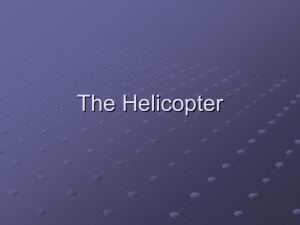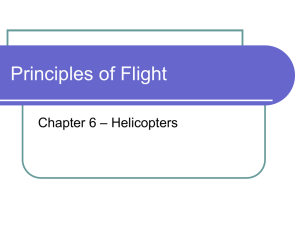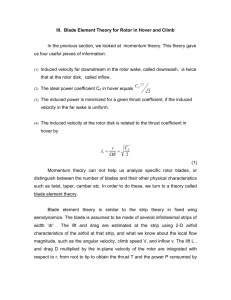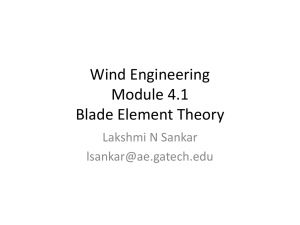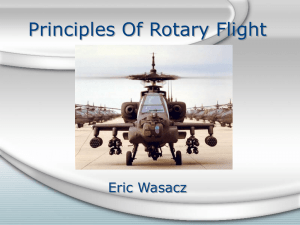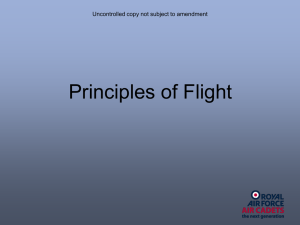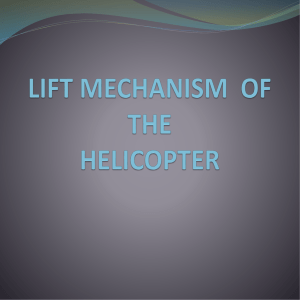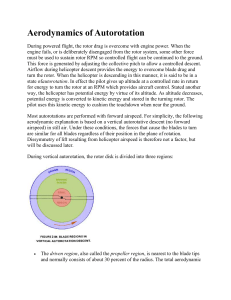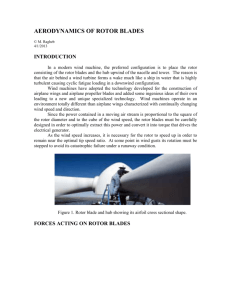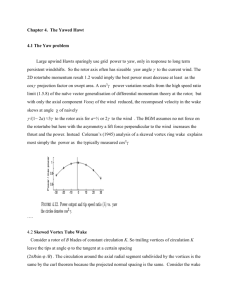Theory of RW Flight Study Guide
advertisement
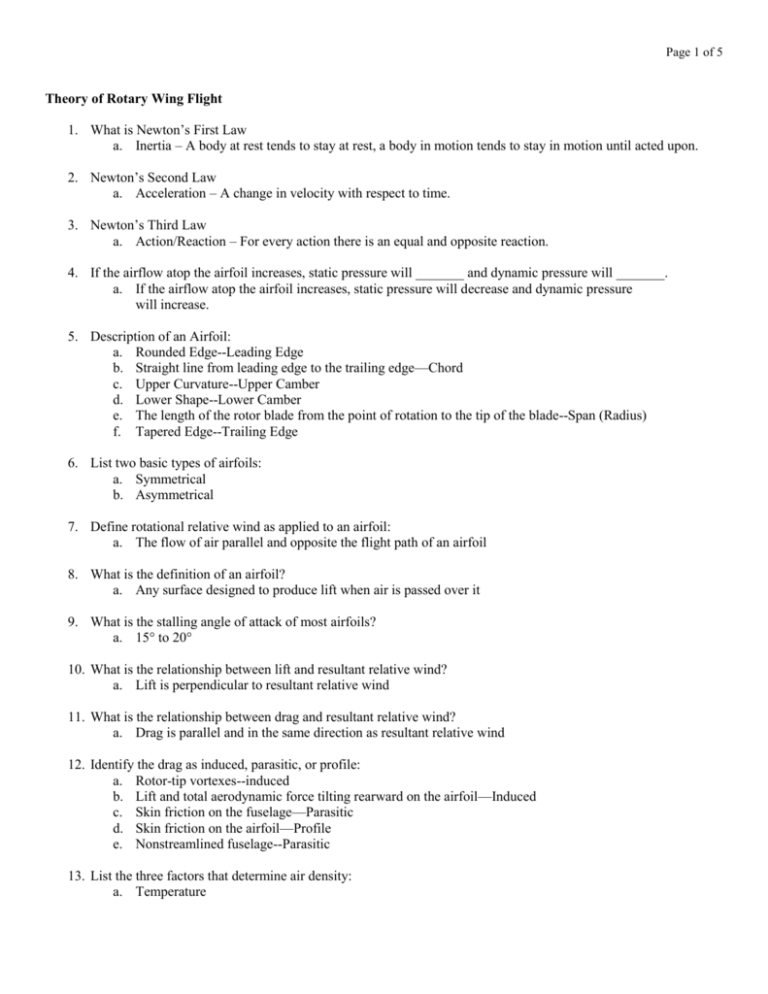
Page 1 of 5 Theory of Rotary Wing Flight 1. What is Newton’s First Law a. Inertia – A body at rest tends to stay at rest, a body in motion tends to stay in motion until acted upon. 2. Newton’s Second Law a. Acceleration – A change in velocity with respect to time. 3. Newton’s Third Law a. Action/Reaction – For every action there is an equal and opposite reaction. 4. If the airflow atop the airfoil increases, static pressure will _______ and dynamic pressure will _______. a. If the airflow atop the airfoil increases, static pressure will decrease and dynamic pressure will increase. 5. Description of an Airfoil: a. Rounded Edge--Leading Edge b. Straight line from leading edge to the trailing edge—Chord c. Upper Curvature--Upper Camber d. Lower Shape--Lower Camber e. The length of the rotor blade from the point of rotation to the tip of the blade--Span (Radius) f. Tapered Edge--Trailing Edge 6. List two basic types of airfoils: a. Symmetrical b. Asymmetrical 7. Define rotational relative wind as applied to an airfoil: a. The flow of air parallel and opposite the flight path of an airfoil 8. What is the definition of an airfoil? a. Any surface designed to produce lift when air is passed over it 9. What is the stalling angle of attack of most airfoils? a. 15° to 20° 10. What is the relationship between lift and resultant relative wind? a. Lift is perpendicular to resultant relative wind 11. What is the relationship between drag and resultant relative wind? a. Drag is parallel and in the same direction as resultant relative wind 12. Identify the drag as induced, parasitic, or profile: a. Rotor-tip vortexes--induced b. Lift and total aerodynamic force tilting rearward on the airfoil—Induced c. Skin friction on the fuselage—Parasitic d. Skin friction on the airfoil—Profile e. Nonstreamlined fuselage--Parasitic 13. List the three factors that determine air density: a. Temperature Page 2 of 5 b. Pressure c. Humidity 14. What relative combination of pressure, temperature, and humidity would produce the greatest lift about an airfoil? a. High pressure b. Low temp c. Low humidity 15. Define Centripetal Force a. An inward force directed at the center of rotation. 16. Define Centrifugal Force a. The outward force produced whenever a body moves in a curved path. 17. What force supplies rigidity to the rotor blades? a. Centrifugal 18. Three causes of blade coning: a. Low rotor RPM b. High gross weight c. High “g” maneuvers 19. Effects of blade coning: a. Loss of disc area and lift b. Stress on blades 20. How is the angle of incidence measured in a rotary-wing aircraft? a. Between the chord of the airfoil and the plane of rotation 21. Which control will vary (constantly change) the angle of incidence of a rotor blade? a. Cyclic pitch control 22. The definition of angle of attack: a. The acute angle between the resultant relative wind and the chord of the airfoil 23. Two possible effects when the blades are out of track: a. Low-frequency vertical vibrations b. Increased instability 24. Why does the helicopter act as a pendulum? a. The center of gravity is located below the supporting elements 25. With rotor systems which rotates counterclockwise, what is the direction in which the fuselage tends to yaw because of torque effect? a. Clockwise 26. How is torque effect overcome in the following helicopters? a. Single rotor - Tail rotor b. Tandem rotor - Opposite rotating main rotors 27. How is torque effect overcome in the following helicopters? Page 3 of 5 a. Single rotor - Tail rotor b. Tandem rotor - Opposite rotating main rotors 28. A pedal turn to the right requires ___(more/less) power than a pedal turn to the left. a. Less 29. List the three methods used to overcome translating tendency in single rotor helicopters: a. Rigging of the cyclic b. Left cyclic c. Tilting the mast 30. What type vibration (high or low frequency) is associated with the tail rotor malfunctions? a. High frequency 31. What is the yaw tendency of a helicopter which has experienced complete loss of tail rotor thrust? a. Yaw right 32. Define Collective feathering a. Pitch changes are equal and simultaneously to all blades. 33. Cyclic feathering a. Increase the pitch of one blade while simultaneously decreasing the pitch of the other blades. 34. Hunting a. Absorbs and relieves stresses produced by flapping 35. Rotation: a. Produces relative wind 36. Flapping: a. Overcomes dissymmetry of lift 37. What is the relationship of total force of the rotor system to the tip-path plane? a. perpendicular 38. List the two components of total force which result when the tip-path plane is tilted, and state the purpose of each component: a. Lift opposes weight and acts vertically b. Thrust opposes drag and acts horizontally c. Lift + Thrust = Total Force 39. List four conditions that would promote “ground effect”: a. Altitude 1¼ rotor diameter or less b. No wind c. Smooth terrain d. Open surfaces 40. List five conditions that would result in the loss or apparent loss of ground effect: a. Beginning of translational movement b. Altitude greater than 1¼ rotor diameter c. Hovering into a wind Page 4 of 5 d. Confined areas e. uneven terrain or tall grass 41. List three conditions necessary for settling with power: a. Vertical or near vertical rate of descent of at least 300 feet per minute. b. Rotor system must be using some of the available engine power ( 20% to 100%) c. Slow airspeed. Less than half of translational lift (10 to 20 knots) 42. Symptoms of settling with power: a. High rate of descent b. High power consumption c. Loss of collective pitch effectiveness d. Vibrations 43. List three flight situations that would be conducive to settling with power: a. Attempting to hover out of ground effect above the hovering ceiling of the aircraft b. Attempting to hover out of ground effect within the hovering ceiling of the aircraft without maintaining precise altitude control c. A steep powered approach in which airspeed is permitted to drop to nearly zero 44. What are the corrective actions for settling with power: a. Increase airspeed with forward cyclic b. Reduce collective pitch c. Adjust rotor RPM to normal operating range 45. The conditions which constitute straight-and-level flight are constant-a. Attitude – airspeed (cyclic) b. Altitude – collective is primary power control c. Direction – heading with cyclic and trim with pedals 46. While in flight you notice your airspeed is 10 knots too fast. To reduce airspeed you must-a. Move the cyclic to the rear 47. You are flying straight and level at 1,500 feet and 90 knots. You desire to reduce airspeed to 60 knots while maintaining altitude, RPM, and heading. What control movements are necessary? a. Cyclic to the rear, lower collective, and apply right pedal 48. Two purposes of cyclic pitch control: a. Tilt the tip-path plane b. Control dissymmetry of lift 49. What is the method used by the pilot to control dissymmetry of lift? a. Cyclic pitch control 50. In an articulated rotor system, assume that a blade flaps up; in which direction will the blades center of gravity move? Will the blade then lead or lag? a. Inboard; lead 51. List five factors that would contribute to ground resonance: a. Bad oleo struts b. Bad drag dampers Page 5 of 5 c. taxiing over uneven ground d. hesitant touchdown e. hard one-skid or wheel landing 52. List two corrective procedures in the event of ground resonance a. If operating RPM exists, get airborne b. If operating RPM does not exist, place firmly on ground, reduce throttle, and go through the normal shutdown procedures 53. What is the direct cause of all stalls? a. Exceeding the critical angle of attack 54. What is the correction for all stalls? a. Reduce the angle of attack to a value less than the critical angle 55. List the factors that contribute to a retreating blade stall: a. High airspeed b. High gross weight c. High “g” maneuvers d. Low air density e. Low rotor RPM f. Turbulence 56. List three symptoms of a retreating blade stall a. Vibrations and shuddering b. Pitch-up tendency c. Left-roll tendency 57. What immediate corrective actions should be initiated if a retreating blade stall occurs? a. Reduce collective and regain control of the aircraft
